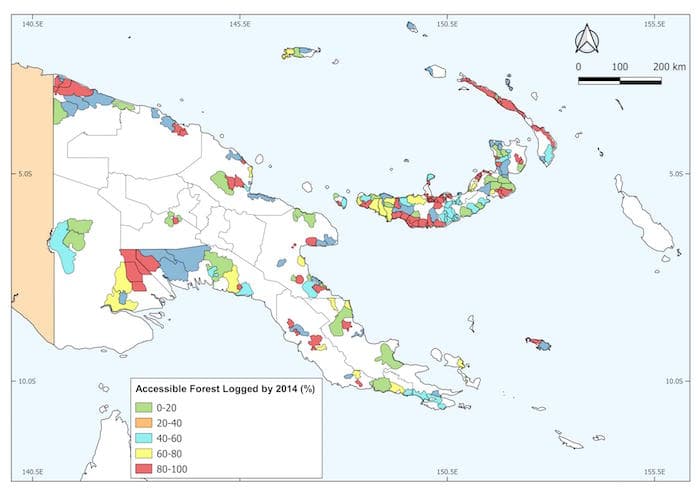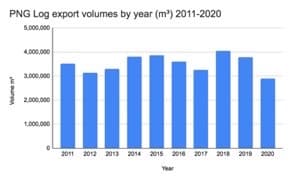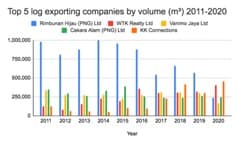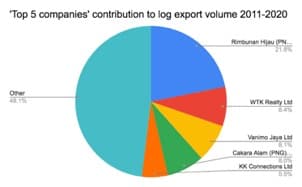Logging and Forest Loss in Papua New Guinea

Download this article as a PDF - Logging and Forest Loss
The forests of Papua New Guinea perform a range of vital functions, supporting communities, ecosystems and the planet as a whole. Despite this, they remain under threat from unsustainable and often illegal logging by foreign logging companies.
The value of Papua New Guinea’s forests
"Papua New Guinea is home to some of the most spectacular natural environment in the world. Although the country makes up less than one per cent of the global land area, it contains more than seven per cent of the world's biodiversity."
Former UN Resident Coordinator in PNG [1]
More than 70% of PNG’s land area is covered by forest.[2] As well as providing a source of food and income for millions of people, PNG’s forests are renowned for their biodiversity – home to at least 191 mammal species, 300 reptile species, 197 amphibians, and over 750 bird species. The forests also sustain complex ecosystems – from the soil, to the watershed to the reef.[3]
Globally, forests absorb around one third of the carbon emitted from burning fossil fuels. PNG’s forests are an important part of this equation: research from 2004 estimated that PNG’s forests had capacity to store the equivalent of nearly 1.5 times the entire emissions from fossil-fuel power stations worldwide.[4] The forests of PNG also contribute to the area’s high rainfall, and deforestation in PNG has the potential to impact local and regional weather patterns - and potentially the global climate.[5]
Forest loss – selling one of the world’s great rainforests
PNG has seen dramatic forest loss in recent decades as the logging industry has boomed.
PNG lost 9 million hectares of primary rainforest between 1972 and 2014 – an area approximately the size of Portugal. [6]
This forest loss includes areas where the land has been completely cleared and areas where primary rainforest has been degraded through selective logging operations.
Between 1972 and 2002, logging was responsible for close to half of all forest loss, with most of the rest due to land clearing for subsistence agriculture. After 2002, logging became a more significant contributor, responsible for 81% of forest loss between 2002 and 2014. Over that time, around 932,000 ha of forest was logged - an area larger than New York City.[7]
PNG’s logging concessions cover a vast area of the country – as at 2014 there were 298 current or proposed logging concessions covering 14.9 million hectares of rainforest.[8] Most concessions are leased and operated by foreign companies – primarily from Malaysia.

The world’s largest exporter of tropical logs
Most of the timber harvested from these logging operations is shipped out of the country as round log exports. As at 2018, PNG was the world’s largest exporter of tropical logs. Over 90% of PNG’s log exports go to China.[9]
Between 2011 and 2020, PNG exported an average of 3.52 million m3 of logs each year. This is significantly higher than the preceding decade (2001-2010) which saw an average of 2.28 million m3 in logs exported each year.[10] PNG log export volumes reached their peak in 2018 at 4.04 million m3 of logs exported.
Chart 1 - Source: SGS Log Export Reports

Exporting the bulk of its timber as round logs means that PNG derives less economic benefit from its timber resources than if the logs were exported as sawn timber, ply, veneer or wood products like furniture. On top of this, Papua New Guinean customary landowners receive only a fraction of the benefits of the logs felled on their land - an average of $6 per m3 or around 6% of PNG’s total log export revenues.[11] In many cases, the impact is doubly felt, as logging operations can damage the forest resources and waterways that customary landowners rely on for food and income.
Who are the logging companies?
Data on log exports is collected and reported by Swiss certification company SGS. The most recent SGS report identifies 43 log export companies active during 2020, some with many subsidiaries.[12] These reports indicate that the log export rates of each company are not static, and have fluctuated over time. In recent years several of the dominant logging companies have seen a reduction in log export levels (see chart 2).
According to the SGS data, the top five log exporting companies are responsible for over 50% of log exports from PNG in the last decade. All the companies within the top five are Malaysian owned. For many, operations first began in Sarawak, Malaysia, before expanding into the Pacific following the depletion of forest resources in Borneo.[13]
|
Company |
Background |
|
Rimbunan Hijau (PNG) Limited |
Rimbunan Hijau (PNG) Limited is a subsidiary of Rimbunan Hijau, a multi-industry Malaysian company operated by the Tiong family who are based in Sarawak. It is one of the largest timber groups in Southeast Asia and was established in 1976.[14] It is headed by Tiong Hiew King, one of Malaysia’s richest men.[15] Rimbunan Hijau has a variety of interests in PNG including mining, oil palm and The National newspaper. Its operations span 15 different countries including Australia and New Zealand.[16] There are 60 or more companies in PNG identified as being owned and controlled by the Tiong family, of which 30 are connected to logging businesses.[17] In 2020, Rimbunan Hijau PNG exported logs from 10 logging concessions: two in Western Province, three in Gulf Province, two in Milne Bay Province and three in West New Britain Province. |
|
WTK Realty Limited
|
WTK Realty Limited is a subsidiary of a Sarawak based Malaysian logging company owned by the Wong family and founded in 1940.[18] WTK has also been linked to Rimbunan Hijau via family connections.[19] It is the oldest of the big five Sarawak based logging companies having been founded in 1940 and owning and managing millions of hectares of forest concessions around the world.[20] In 2020 WTK Realty or its subsidiaries exported logs from six logging concessions in PNG: one in Milne Bay Province, one in Madang, one in West Sepik and three in East New Britain Province. |
|
Vanimo Jaya Limited
|
Vanimo Jaya Limited is owned and operated by Malaysian nationals.[21] SGS data indicates that in 2020, Vanimo Jaya recorded its lowest export volume for the decade (see chart 2). In 2020 Vanimo Jaya exported logs from one concession – the Makapa concession in Western Province. |
|
Cakara Alam Limited
|
Cakara Alam was first registered in PNG in 1988. Since 2000, it has been wholly owned by C.A. Investments Limited, a company registered in Labuan in Malaysia, a tax haven.[22] In 2020, Cakara Alam or its subsidiaries exported logs from five logging concessions, one in East New Britain Province and four in West New Britain Province.[23] |
|
KK Connections Limited (including log exports from Kerawara Limited)
|
Prior to 2018, KK Connections was listed as a subsidiary of Kerawara Limited in the SGS reports. In 2018, Kerawara ceased exporting logs and KK Connections became a stand-alone exporter in the SGS reports. Logging concessions in Central and East New Britain which were originally held by Kerawara, are now held by KK Connections.[24] Due to this, data for both companies have been combined to better represent their joint contribution. Together, KK Connections and Kerawara have seen a 750% increase in log exports in the last decade, from 60,803m3 in 2013 to 456,450m3 in 2020. |
Rimbunan Hijau, traditionally the biggest player in the logging industry, has seen a downward trend of export rates in the last four years. In 2020, RH was responsible for only 7.3% of PNG’s log exports, compared with 27.9% in 2011. The reasons for this shift are unclear, although factors may include an increased interest in other investments both inside and outside PNG, the COVID-19 pandemic, recent resistance to expansion into new forest areas and increased audit oversight.[25] Over the same period, WTK Realty and Kerawara Limited have seen an increase in export rates.[26]
Chart 2 – Source: SGS Log Export Reports

Other companies outside of the top five constitute 48.1% of log exports from PNG from over the last decade. Many of these companies have not been consistent exporters over the past decade, and all have relatively low log export volumes compared to the top five.
Chart 3 - Source: SGS Log Export Reports

Want more information?
Read From Extraction to Inclusion: Changing the Path to Development in Papua New Guinea: https://www.jubileeaustralia.org/our-impact-areas/sustainable-economies/from-extraction-to-inclusion
Data on log exports by company, province and concession type can be viewed at https://pngiforests.org
Information on PNG company ownerships can be accessed at https://www.ipa.gov.pg/ and https://pngiportal.org/
Footnotes
1. UNDP, “UNDP urges PNG to protect its biodiversity on World Environment Day June 5”, Media Release, 5 June 2017.
2. Bryan and Shearman (2015) The State of Forests of Papua New Guinea 2014, University of PNG, Port Moresby, available at: https://png-data.sprep.org/dataset/state-forests-papua-new-guinea-2014, at p. 13.
3. Phil Shearman, Jane Bryan, Julian Ash, Peter Hunnam, Brendan Mackey, Barbara Lokes (2008) The State of the Forests of Papua New Guinea 2002, University of PNG, Port Moresby, at pp 16-17.
4. Greenpeace (2008) Preserving Paradise: The Value of Protecting Papua New Guinea’s Forests for Climate, Amsterdam, Greenpeace International at p. 7.
5. See: A. M. Makarieva & V. G. Gorshkov, “Large-scale climatic significance of Papua New Guinea forests” in Bryan and Shearman at p. 49-50.
6. Luke Fletcher (2020) From Extraction to Inclusion, ActNow!, Jubilee Australia and Oakland Institute, available at: https://www.jubileeaustralia.org/our-impact-areas/sustainable-economies/from-extraction-to-inclusion at p. 51.
7. Bryan and Shearman at p. 17-19.
8. Bryan and Shearman at p. 24.
9. International Tropical Timber Association (ITTO) (2018) Biennial Review and Assessment of the World Timber Situation, 2017-2018, available at: https://www.itto.int/annual_review/ at p. 21, 94-95.
10. PNGi Forests Portal, ‘Log Exports By Province’, available at: https://pngiforests.org/.
11. Micah G. Scudder, Jack Baynes, John Herbohn, ‘Timber royalty reform to improve the livelihoods of forest resource ownersin Papua New Guinea’ (2019) Forest Policy and Economics 100: 113-119 at 114.
12. SGS (2021) Log Export Monitoring Monthly Report – December 2020 at pp. 11-1 to 11-11; See, for example, discussion of Rimbunan Hijau’s network of subsidiaries in Frederic Mousseau and Peiley Lau, The Great Timber Heist: the Logging Industry in Papua New Guinea (The Oakland Institute).
13. Luke Fletcher, ‘From Extraction to Inclusion’ (2020), ActNow!, Jubilee Australia and Oakland Institute.
14. Gabriel, Jennifer and Michael Wood (2015) ‘The Rimbunan Hijau Group in the Forests of Papua New Guinea’ The Journal of Pacific History 50(3) 322, 322.
15. Africa Confidential. Who’s Who: Tiong Hiew King. http://www.africaconfidential.com/whos-who-profile/id/3103 (accessed October 15, 2012).
16. RH Group website. http://www.rhg.com.my (accessed August 26, 2013).
17. The Oakland Institute (2016) ‘The Great Timber Heist; The Logging Industry in Papua New Guinea,’ p. 16
18. Oxfam, ‘Banking on shaky ground’ (2017) p. 14
19. Oakland institute (2016) p. 18.
20. Oxfam, ‘Banking on shaky ground’ (2017) p. 14
21. PNGiforests, ‘Logging Companies – Vanimo Jaya Limited’ Empowering Forest Communities, Increasing transparency around forest management in Papua new Guinea (Website), available at: https://pngiforests.org/company/vanimo-jaya#linked-people-card.
22. PNGiCentral, ‘Logging Company Sends Police to Terrorise village Leader’ PNGi -Investigate, Analyse and Expose, available at: https://pngicentral.org/reports/logging-company-sends-police-to-terrorise-village-leader#who-is-cakara-alam
23. PNGiforests, ‘Logging companies – Cakara Alam (PNG) Limited’, available at: https://pngiforests.org/company/cakara-alam-png
24. PNGiforests, ‘Logging Companies – KK Connections Limited’, available at: https://pngiforests.org/company/kk-connections.
25. PNGiCentral, ‘Is Rimbunan Hijau Ending its Plunder of PNG Forests?’ PNGi -Investigate, Analyse and Expose, available at: https://pngicentral.org/reports/is-rimbunan-hijau-ending-its-plunder-of-png-forests
26. SGS Log Export Monitoring Monthly Report, 2011-2020.
